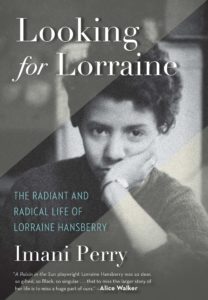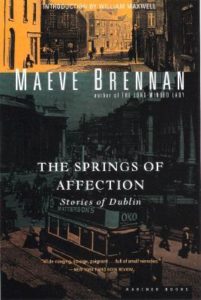
This week in criticism saw a spotlighting of the life and work of two remarkable, but often overlooked, midcentury writers: Brandon Tensley’s Slate review of Looking for Lorraine—Imani Perry’s biography of civil rights activist and A Raisin in the Sun author Lorraine Hansberry—and Joanne O’Leary’s London Review of Books essay on Irish short story writer and New Yorker journalist Maeve Brennan. Over at the New York Times, the novelist Colm Tóibín praises Esi Edugyan’s “fierce and unsettling” Washington Black, and how it “complicate[s] the historical narrative by focusing on one unique and self-led figure.” We’ve also got Claire Fallon’s Huffington Post flaying of James Frey’s Katerina, in which she wonders: “Why do we keep giving all those extra chances to less-than-mediocre men?”, and Parul Sehgal marvels at how Brian Dillon creates crystalline pieces out of disarray in his new collection, Essayism.
*
“Edugyan is determined that the fate of Washington Black will not be dictated by history, that the novel instead will give him permission to soar above his circumstances and live a life that has been shaped by his imagination, his intelligence and his rich sensibility. He is not a pawn in history so much as a great noticer in time, with astonishing skill at capturing the atmosphere in a room, matched by his talent with pencil and sketchbook. He is a born artist, and someone who attracts people to him. He is also a lost soul who moves through the novel as though in search of some distant, sorrowful notion of home. … In this portrait of the artist as a young man, Edugyan demands that the reader take the mixtures in Washington seriously … Edugyan is willing to take great risks to release the reader from any easy or predictable interpretations of Washington. She is not afraid to allow him to have thoughts and knowledge that seem oddly beyond his command. That is part of his ambiguous power in the book, the idea that, owing to his unusual quickness and subtlety of mind, Washington can be trusted to know more than he should. His place in this changing, dangerous world is not fixed. Social realism will not help him on his picaresque journey … What Edugyan has done in Washington Black is to complicate the historical narrative by focusing on one unique and self-led figure. Washington Black’s presence in these pages is fierce and unsettling. His urge to live all he can is matched by his eloquence, his restless mind striving beyond its own confines in tones that are sometimes overstretched, if brilliant, and then filled with calm subtlety and nuance.”
–Colm Tóibín on Esi Edugyan’s Washington Black (The New York Times Book Review)
*

“Using her own personal interest in Hansberry—best known today as the playwright of A Raisin in the Sun—as narrative scaffolding, Perry mines Hansberry’s life, her indefatigable radicalism, and her queerness, and she prods us to consider what this fuller portrait of a categorically transgressive figure reveals about the state of social justice today … most of what we know about Hansberry’s identity as a lesbian stems from her private writings: essays, letters, poetry, short stories. Perry treats these texts (many of them available only since 2010) with care, tenderly pulling back the veil on a woman who committed her craft to investigating the various facets of identity … This literal looking for Lorraine transposes Hansberry into the present, into the Black Lives Matter era—and Perry isn’t timid about pointing out how contemporary society still buckles morally on some matters of acceptance … In fitting herself into Hansberry’s story with autobiographical elements, Perry offers a bracing air of familiarity and urgency around the artist, whose legacy has faded since her death from cancer in 1965. (She was only 34 years old.) By crisscrossing then and now, Perry insists how important it is that our connection to this history—to Hansberry—survive. Because by learning more about her—revisiting the keen ways in which she interrogated America and its endless betrayals—we, too, are encouraged to become our best and most radical selves.”
–Brandon Tensley on Imani Perry’s Looking for Lorraine (Slate)
*

“In New Yorker lore, the platitudes used of her—‘changeling’, ‘fairy princess’—point to something fugitive, just as the Dublin stories, on which her reputation as a fiction writer depend, have a preternatural ability to seem intimate while keeping the reader at arm’s length … At the New Yorker, with her ‘longshoreman’s mouth’ and ‘tongue that could clip a hedge’, she made her opinions known. Daphne du Maurier was ‘witless’, Jean Stafford a ‘bête noire’. Brennan immediately set her sights on grander things than the fashion notes and short reviews she’d been hired to write. In 1952, her first story appeared; two years later, she had a piece in ‘The Talk of the Town’, the section of the magazine over which Shawn kept the tightest of reins. Brennan’s male colleagues, including Addams, Joseph Mitchell and Brendan Gill (all of them her lovers at one time or another), joked that she had served her apprenticeship in hemlines. But it was the ability to spot the difference between ‘beige’ and ‘bone’ at fifty yards that made her a natural diarist. John Updike said her ‘Talk of the Town’ pieces ‘helped put New York back into the New Yorker’ … What I’m looking for, maybe unfairly, is a way of reconciling the Brennan who basked in the ‘lavish solitude’ of ‘small, inexpensive restaurants’—‘the home fires of New York City’—with the Brennan who sparkles in her colleagues’ memoirs. The New Yorker columns bear no trace of the woman who went to a party hosted by E.B. White and silenced the room by yelling: ‘Fuck you, Brendan Gill, you goddamn Roman Catholic!’ In her own telling, or the lady’s, her evenings sound desperately lonely: Billie Holiday on a loop, all that rain, all those cats. It’s difficult to imagine this being the same woman who, working on a corridor nicknamed Sleepy Hollow, pegged the door open, brought in potted plants, and painted her office ceiling Wedgwood blue … It was Brennan’s gift, and her trouble, that she saw things most clearly when they were half-destroyed. In her non-fiction, the transience of Manhattan is described with an intensity befitting a love affair.”
–Joanne O’Leary on the life and work of Maeve Brennan (The London Review of Books)
*
“Why do we keep giving all those extra chances to less-than-mediocre men? … The book sucks … Katerina is the novel any weedy college bro high on Henry Miller and the Beat poets would write if he kept banging away at his vintage Olivetti long enough: hysterically emotive, narratively pedestrian, exhilarated by its own borrowed style … This plot reeks of wish-fulfillment―the gorgeous, desirable model; their charmed love story; her candle held for him decades later; his destiny as the one writer in his generation who would, as he puts it, ‘burn the fucking world down’ … A doomed romance can certainly be compelling, with the aid of fresh language or lively characters. But Katerina wafts through the novel as little more than a sexy red pout atop two long shapely gams, and the narrator, while enraptured by his own navel, never manages to describe that navel, or the affair, with anything approaching insight or originality … His favorite words include classics like ‘fuck,’ ‘life,’ ‘crazy,’ ‘pain,’ ‘sex,’ ‘art’ and ‘love,’ and he’s unafraid to reuse them, often many times on the same page … It’s as though Frey can’t think of any fresh ways to say or describe things, so he resorts to repeating his words, hoping the repetition will stand in for throbbing inspiration.”
–Claire Fallon on James Frey’s Katerina (Huffington Post)
*
“Dillon is a mournful, witty and original writer … He celebrates the essay as a form born of contradictions between tradition and innovation, fragmentation and wholeness, autobiography and artifice. It is a beautiful container for irreconcilable desires and impossible ambitions … Dillon’s mode is rhapsody, not analysis. He invites us to gawk at his intellectual crushes—their shapely sentences, wily inversions, daring transitions … he moves with a hummingbird energy, flitting to the next writer, the next effect he loves … He often writes in generalities—but they bristle with clues, with suggestive and, yes, odd language. His tenderness for the essay is for the moment when its reach exceeds its grasp … Out of that disarray come these crystalline pieces—and a sense, never belabored, of the stakes of creating essays and the consolations of loving them”
–Parul Sehgal on Brian Dillon’s Essayism (The New York Times Book Review)

